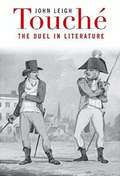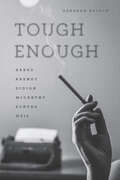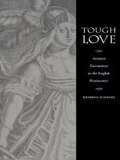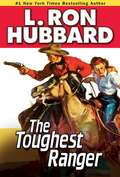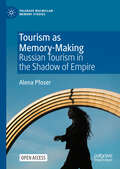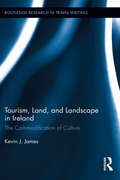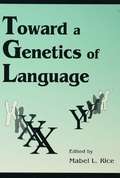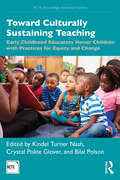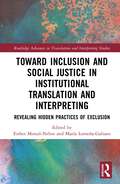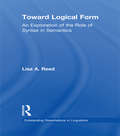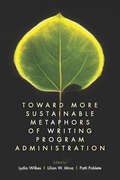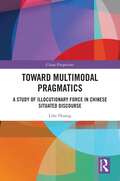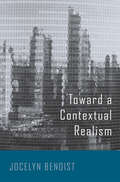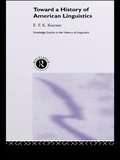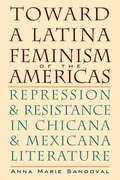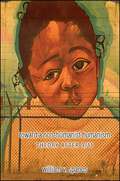- Table View
- List View
Touché: The Duel in Literature
by John LeighMany of the West's best writers fought in duels or wrote about them, seduced by glamour or risk or recklessness. A gift as a plot device, the duel also offered a way to discover how we face fears of humiliation, pain, and death. John Leigh's literary history of the duel illuminates these and other tensions attending the birth of the modern world.
Tough Enough: Arbus, Arendt, Didion, McCarthy, Sontag, Weil
by Deborah NelsonThis book focuses on six brilliant women who are often seen as particularly tough-minded: Simone Weil, Hannah Arendt, Mary McCarthy, Susan Sontag, Diane Arbus, and Joan Didion. Aligned with no single tradition, they escape straightforward categories. Yet their work evinces an affinity of style and philosophical viewpoint that derives from a shared attitude toward suffering. What Mary McCarthy called a “cold eye” was not merely a personal aversion to displays of emotion: it was an unsentimental mode of attention that dictated both ethical positions and aesthetic approaches. Tough Enough traces the careers of these women and their challenges to the pre-eminence of empathy as the ethical posture from which to examine pain. Their writing and art reveal an adamant belief that the hurts of the world must be treated concretely, directly, and realistically, without recourse to either melodrama or callousness. As Deborah Nelson shows, this stance offers an important counter-tradition to the familiar postwar poles of emotional expressivity on the one hand and cool irony on the other. Ultimately, in its insistence on facing reality without consolation or compensation, this austere “school of the unsentimental” offers new ways to approach suffering in both its spectacular forms and all of its ordinariness.
Tough Love: Amazon Encounters in the English Renaissance
by Kathryn SchwarzIn Tough Love Kathryn Schwarz takes up a range of literary, historical, and theoretical texts in order to examine the relationship between Amazon myth and the social conventions that governed gender and sexuality during the early modern period. Imagined as embodiments of female masculinity, amazonian figures stimulated both homoerotic and heteroerotic response, and Schwarz shows that their appearance in narratives disrupted assumptions concerning identity, gender, domesticity, and desire. Despite seeming to function as signs for what is outside the social--the alien, the exotic, the other--Amazons in sixteenth- and seventeenth-century texts were often represented in conventionally domestic roles, as mothers and lovers, wives and queens, Schwarz demonstrates. She traces this pattern in works by Shakespeare, Spenser, Sidney, Raleigh, and Jonson, as well as in such materials as conduct manuals, explorers' accounts, court spectacles, and political tracts. Through readings of these texts, Schwarz shows that the Amazon myth provided a language both for setting forth and for challenging the terms of social logic. In representations of Amazon encounters, she argues, homosocial bonds became indistinguishable from heterosexual desires, masculine agency attached itself as logically to women as it did to men, and sexual difference was made nearly impossible to sustain or define. Schwarz's analysis unveils the Amazon as a theoretical term, one that illuminates the tensions and paradoxes through which ideologies of the domestic take shape. Tough Love contributes to the ongoing discussion of gendered identity and sexual desire in the early modern period. It will interest students of queer theory, cultural studies, early modern history, feminism, and literature.
Toughest Ranger, The
by L. Ron HubbardEnjoy this tale from the wild, wild west. Cowboy Petey McGuire has been kicked around so much that he's turned forlorn, self-despairing and gun-shy. Yet starvation has a way of changing a man and so, armed only with his attitude and a hungry belly, Petey finds his way to the headquarters of the Arizona Rangers looking for a job.Petey also finds a new ornery personality; he claims to be the toughest man around from Kansas City to N'Orleans, a man so tough he'd give a rattler nightmares. But when the chief Ranger, Captain Shannon, calls Petey's bluff and sends him after the most dangerous desperado in the state, Petey must discover what it really means to be Ranger-tough. ALSO INCLUDES THE WESTERN STORIES "THE RANCH THAT NO ONE WOULD BUY" AND "SILENT PARDS""With the flair of a Louis L'Amour or Zane Grey.." --True West
Touring Shakespeare: Theatre and Post-War Cultural Diplomacy
by Jim TaylorDrawing on a remarkable wealth of archival material, Touring Shakespeare reveals how English Shakespeare companies were deployed overseas in service to British diplomatic interests at the end of Empire and the start of the Cold War. In exploring the politics behind the global dissemination of Shakespeare performed by prominent English theatre companies like The Old Vic and The Shakespeare Memorial Theatre, Jim Taylor considers whether tours supported, contradicted, or ran adjacent to the broader diplomatic objectives they served. Peeling back layers of production and reception history in such diverse locations as Egypt, India, Nigeria, and Australia, his study discloses how the British state came to regard Shakespeare tours as an effective compensatory device for its loss of economic and political power overseas, and how the global Shakespeare myth was driven by British cultural institutions between 1939 and 1965.
Tourism as Memory-Making: Russian Tourism in the Shadow of Empire (Palgrave Macmillan Memory Studies)
by Alena PfoserUntil recently the Russian Federation used to be one of the largest markets for outbound travel. Among Russians’ favourite destinations were cities that used to be part of the Russian Empire and the Soviet Union, and are now located in the independent nation-states bordering Russia. This open access book provides an empirically rich and conceptually sophisticated account of the mnemonic interactions between Russians and their neighbours in the shadow of empire and geopolitical confrontations. Based on extensive ethnographic research with tourists and tour guides in the cities of Tallinn, Kyiv, and Almaty before Russia’s full-scale war on Ukraine, it analyses the practices through which cultural memories are performed in tourism encounters, as well as the forms they take. Imperial nostalgia, the production and consumption of national pasts, and memory diplomacy are discussed as key modes of remembering in tourism. Through the case of Russian tourism, the book argues for an invigoration of research on memory and tourism, which despite the significance of tourism for the circulation of cultural memories has so far received surprisingly little attention. Bringing debates in memory, heritage and tourism studies into a dialogue, the book expands the field of study beyond museums and heritage sites and puts forward a transnational approach that acknowledges diverse and entangled modes of remembering in tourism, situates memory-making in a wider political context and reflects on its geopolitical implications.
Tourism, Land and Landscape in Ireland: The Commodification of Culture (Routledge Research in Travel Writing #9)
by K. J. JamesThis study, exploring a broad range of evocative Irish travel writing from 1850 to 1914, much of it highly entertaining and heavily laced with irony and humour, draws out interplays between tourism, travel literature and commodifications of culture. It focuses on the importance of informal tourist economies, illicit dimensions of tourism, national landscapes, ‘legend’ and invented tradition in modern tourism.
Tours et détours: Le mythe de Babel dans la littérature contemporaine
by Catherine KhordocTours et détours examine l’inscription du mythe de Babel dans la littérature contemporaine de langue française. Le mythe s’avère une source d’inspiration pour les auteurs examinés qui évoquent justement des phénomènes sociaux actuels, tels que le multiculturalisme, l’immigration, l’exil, la pluralité des langues, la traduction et l’identité. Les ouvrages étudiés, tous écrits en français mais issus de différents contextes linguistiques et culturels, mettent en lumière de nouvelles interprétations du mythe de Babel. Pendant longtemps le mythe de Babel et la pluralité linguistique et culturelle qui s’ensuivent ont été considérés une malédiction pour l’humanité, mais les romans à l’étude remettent en question cette vision négative. Sans exalter les bienfaits de la multiplicité, ils considèrent comment la pluralité linguistique et culturelle enrichit et façonne la production littéraire ainsi que le monde contemporain. Les auteurs et œuvres étudiés sont • Monique Bosco, Babel-Opéra • Hédi Bouraoui, Ainsi parle la tour CN • Francine Noël, Babel, prise deux ou Nous avons tous découvert l’Amérique • Ernest Pépin, Tambour-Babel • Jorge Semprun, L’Algarabie
Toward A Competitive Telecommunication Industry: Selected Papers From the 1994 Telecommunications Policy Research Conference (LEA Telecommunications Series)
by Gerald W. BrockProviding an authoritative perspective on the best current research regarding telecommunication policy, this book is based on the 22nd Annual Telecommunications Policy Research Conference. The papers focus on the critical policy issues created by increasing competition in the industry. The book contains a careful analysis of local competition and interconnection, international competition, universal service issues, the Internet and emerging new methods of communication, and the first amendment problems created by changing telecommunication technology. It brings together -- in a convenient form -- a wide range of important scholarship on telecommunication policy that otherwise would require extensive research into a variety of journals, government filings, and unpublished papers.
Toward A Genetics of Language
by Mabel L. RiceThe past decade has brought important new advances in the fields of genetics, behavioral genetics, linguistics, language acquisition, studies of language impairment, and brain imaging. Although these advances are each highly relevant to the determination of what a child is innately prepared to bring to language acquisition, the contributing fields of endeavor have traditionally been relatively self-contained, with little cross communication. This volume was developed with the belief that there is considerable value to be gained in the creation of a shared platform for a dialogue across the disciplines.Leading experts in genetics, linguistics, language acquisition, language impairment, and brain imaging are brought together for the purpose of exploring the current evidence, theoretical issues, and research challenges in a way that bridges disciplinary boundaries and points toward future developments in the search for the genetic and environmental bases of language acquisition and impairments. This collection provides discussions and summaries of: *breakthrough findings of the genetic underpinnings of dyslexia; *theoretical and empirical developments in the specification of a phenotype of language acquisition and impairment; *evidence of familiarity and twin concordances of specific language impairment; and*new evidence from brain imaging.It concludes with a critical response from an advocate of rational empiricism.
Toward Culturally Sustaining Teaching: Early Childhood Educators Honor Children with Practices for Equity and Change (NCTE-Routledge Research Series)
by Kindel Turner NashDemonstrating equitable practices and strategies that move toward culturally sustaining teaching such as translanguaging, explorations of children’s literature, alternative modes of literacy assessment, photography and arts integration, student-driven poetry units, and more, this book shares the stories of four teacher–teacher dyads who worked together across university–school contexts to study, generate, and evaluate culturally relevant and sustaining literacy practices in early childhood classrooms across the country. Highlighting the voices and roles of children, families, community members, and teachers of Color, this book suggests new ways for all teachers to build and sustain relationships that are relevant and work toward being sustaining; and anticipates and offers solutions for challenges that arise in these contexts. Insightful and instructive, the narratives in this collection model how to create positive and mutually beneficial dynamics among teachers, children, and their families and communities. This book offers a timely resource for pre-service teachers, teachers, scholars, faculty, and graduate students in language and literacy education, early childhood education, and culturally relevant, responsive, and sustaining teaching.
Toward Defining the Prairies: Region, Culture, and History
by Robert WardhaughNew ways of thinking about literature and history have radically changed how we think about or even "define" a region like the Prairie West. In fact, the very concept of "defining" has come into question by new theoretical approaches and it may now seem a hopeless endeavour. But the process of defining can be just as important as the actual production of a definition.Toward Defining the Prairies highlights recent approaches to thinking about the Prairie West. Bounded by pieces from well-known historian Gerald Friesen and Governor-General's Award-winning writer Robert Kroetsch, these 13 essays are as diverse as the region itself. In their examination of different aspects of Prairie history, literature, climate, society, culture, and identity, they help to provide a new understanding of this place and of the complexities of its definition.
Toward Inclusion and Social Justice in Institutional Translation and Interpreting: Revealing Hidden Practices of Exclusion (ISSN)
by María Lomeña-Galiano Esther Monzó-NebotThis collection re-envisions the academic study of institutional translation and interpreting (ITI), revealing oppression in established institutional spaces toward challenging existing policies and the myths which inhibit critical inquiry within the field.ITI is broadly conceived here as translation and interpreting delivered in or for specific institutions, understood as social systems and spanning national, supranational, and international organizations as well as immigration detention centers, prisons, and national courts. The volume is organized around three parts, which explore ITI spaces and practices revealing oppressive practices, dispelling myths regarding translation and interpreting, and shedding light on institutional spaces that have remained invisible and hidden, and therefore underexplored. The chapters in this book vividly illustrate similarities and contrasts between the different contexts of ITI, revealing shared power dynamics that uphold social hierarchies. Throughout this comparison, the book makes a compelling case to consider the different contexts of ITI as equally contributing to actionable knowledge on how institutions shape translation and interpreting and how these are operated in sustaining such hierarchies.Offering a window into previously underexplored spaces and generating new lines of inquiry within ITI studies, this book will be of interest to scholars and policymakers in translation and interpreting studies.
Toward Logical Form: An Exploration of the Role of Syntax in Semantics (Outstanding Dissertations in Linguistics)
by Lisa A. ReedFirst Published in 1997. This book is devoted to an in-depth investigation of some of the properties of Logical Form (LF). The syntactic analyses argued for in this book are couched in terms of Chomsky’s Principles and Parameters approach prior to its most recent version known as “Minimalism” (Chomsky, 1995). However, the model of the syntax-semantics interface advocated in this book remains intact under minimalist assumptions, as the aspects of the syntactic representation known as LF investigated here have remained unaltered in the most recent version of generative syntax.
Toward More Sustainable Metaphors of Writing Program Administration
by Lydia Wilkes Lilian W. Mina Patti PobleteThe field of writing program administration has long been a space rich in metaphor. From plate-twirling to fire-extinguishing, parents to dungeon masters, and much more, the work of a WPA extends to horizons unknown. Responding to the constraints of austerity, Toward More Sustainable Metaphors of Writing Program Administration offers new lenses for established WPAs and provides aspiring and early career WPAs with a sense of the range of responsibilities and opportunities in their academic and professional spaces. This volume presents twelve chapters that reclaim and revise established metaphors; offer new metaphors based on sustainable, relational, or emotional labor practices and phenomena; and reveal the improvisational, artisanal nature of WPA work. Chapters resonate across three sections. The first section focuses on organic relationships captured in phrases like “putting out fires” and "seeing forests for the trees” alongside unexpected comparisons to ground and light. The second describes institutional landscapes featuring generative juxtapositions such as the WPA as a labor activist or a mapper of emotional geography. And the third discusses performance crafts like improv comedy and artisanal making. Toward More Sustainable Metaphors of Writing Program Administration offers new and revised ways of thinking and acting for WPAs, who are constantly negotiating the paradoxical demands of their work and continually striving to act ethically in conflicted, and even fraught, situations. It will inspire practicing, aspiring, and former WPAs working in a time of transformation by highlighting more sustainable ways of enacting WPA identity. Contributors: Jacob Babb, John Belk, Katherine Daily O'Meara, Ryan J. Dippre, Douglas Hesse, Andrew Hollinger, Rona Kaufman, Cynthia D. Mwenja, Manny Piña, Scott Rogers, Robyn Tasaka, Alexis Teagarden, Christy I. Wenger, Lydia Wilkes
Toward Multimodal Pragmatics: A Study of Illocutionary Force in Chinese Situated Discourse (China Perspectives)
by Lihe HuangClassic pragmatic theories emphasize the linguistic aspect of illocutionary acts and forces. However, as multimodality has gained importance and popularity, multimodal pragmatics has quickly become a frontier of pragmatic studies. This book adds to this new research trend by offering a perspective of situated discourse in the Chinese context. Using the multimodal corpus approach, this study examines how speakers use multiple devices to perform illocutionary acts and express illocutionary forces. Not only does the author use qualitative analysis to study the types, characteristics, and emergence patterns of illocutionary forces, he also performs a quantitative, corpus-based analysis of the interaction of illocutionary forces, emotions, prosody, and gestures. The results show that illocutionary forces are multimodal in nature while meaning in discourse is created through an interplay of an array of modalities. Students and scholars of pragmatics, corpus linguistics, and Chinese linguistics will benefit from this title.
Toward Translingual Realities in Composition: (Re)Working Local Language Representations and Practices
by Nancy Bou AyashToward Translingual Realities in Composition is a multiyear critical ethnographic study of first-year writing programs in Lebanon and Washington State—a country where English is not the sole language of instruction and a state in which English is entirely dominant—to examine the multiple and often contradictory natures, forces, and manifestations of language ideologies. The book is a practical, useful way of seriously engaging with alternative ways of thinking, doing, and learning academic English literacies. Translingualism work has concentrated on critiquing monolingual and multilingual notions of language, but it is only beginning to examine translingual enactments in writing programs and classrooms. Focusing on language representations and practices at both the macro and micro levels, author Nancy Bou Ayash places the study and teaching of university-level writing in the context of the globalization and pluralization of English(es) and other languages. Individual chapters feature various studies that Bou Ayash brings together to address how students act as agents in marshaling their language practices and resources and shows a deliberate translingual intervention that complicates and enriches students’ assumptions about language and writing. Her findings about writing programs, instructors, and students are detailed, multidimensional, and complex. A substantial contribution to growing translingual scholarship in the field of composition studies, Toward Translingual Realities in Composition offers insights into how writing teacher-scholars and writing program administrators can more productively intervene in local postmonolingual tensions and contradictions at the level of language representations and practices through actively and persistently reworking the design and enactment of their curricula, pedagogies, assessments, teacher training programs, and campus-wide partnerships.
Toward a Contextual Realism
by Jocelyn BenoistAn award-winning philosopher bridges the continental-analytic divide with an important contribution to the debate on the meaning of realism. Jocelyn Benoist argues for a philosophical point of view that prioritizes the concept of reality. The human mind’s attitudes toward reality, he posits, both depend on reality and must navigate within it. Refusing the path of metaphysical realism, which would make reality an object of speculation in itself, independent of any reflection on our ways of approaching it or thinking about it, Benoist defends the idea of an intentionality placed in reality—contextualized. Intentionality is an essential part of any realist philosophical position; Benoist’s innovation is to insist on looking to context to develop a renewed realism that draws conclusions from contemporary philosophy of language and applies them methodically to issues in the fields of metaphysics and the philosophy of the mind. “What there is”—the traditional subject of metaphysics—can be determined only in context. Benoist offers a sharp criticism of acontextual ontology and acontextual approaches to the mind and reality. At the same time, he opposes postmodern anti-realism and the semantic approach characteristic of classic analytic philosophy. Instead, Toward a Contextual Realism bridges the analytic-continental divide while providing the foundation for a radically contextualist philosophy of mind and metaphysics. “To be” is to be in a context.
Toward a History of American Linguistics (Routledge Studies in the History of Linguistics #Vol. 5)
by E.F.K. KoernerBeginning with the anthropological linguistic tradition associated primarily with the names of Franz Boas, Edward Sapir and their students and concluding with the work of Noam Chomsky and William Labov at the end of the century. This book offers a comprehensive account of essential periods and areas of research in the history of American Linguistics and also addresses contemporary debates and issues within linguistics.Topics covered include: * The sources of the 'Sapir-Whorf Hypothesis' * Leonard Bloomfield and the Cours de linguistique générale * The 'Chomskyan Revolution' and its Historiography * The Origins of Morphophonemics in American Linguistics *William Labov and the Origins of Sociolinguistics in America.Toward a History of American Linguistics will be invaluable reading for academics and advanced students within the fields of linguistics and the history of linguistics.
Toward a Latina Feminism of the Americas: Repression and Resistance in Chicana and Mexicana Literature
by Sandoval Anna MarieWeaving strands of Chicana and Mexicana subjectivities, Toward a Latina Feminism of the Americas explores political and theoretical agendas, particularly those that undermine the patriarchy, across a diverse range of Latina authors. Within this range, calls for a coalition are clear, but questions surrounding the process of these revolutionary dialogues provide important lines of inquiry. Examining the works of authors such as Sandra Cisneros, Laura Esquivel, Carmen Boullosa, and Helena María Viramontes, Anna Sandoval considers resistance to traditional cultural symbols and contemporary efforts to counteract negative representations of womanhood in literature and society. Offering a new perspective on the oppositional nature of Latina writers, Sandoval emphasizes the ways in which national literatures have privileged male authors, whose viewpoint is generally distinct from that of women-a point of departure rarely acknowledged in postcolonial theory. Applying her observations to the disciplinary, historical, and spatial facets of literary production, Sandoval interrogates the boundaries of the Latina experience. Building on the dialogues begun with such works as Sonia Saldivar-Hull's Feminism on the Border and Ellen McCracken's New Latina Narrative , this is a concise yet ambitious comparative approach to the historical and cultural connections (as well as disparities) found in Chicana and Mexicana literature.
Toward a Non-humanist Humanism: Theory after 9/11
by William V. SpanosIn his book The End of Education: Toward Posthumanism, William V. Spanos critiqued the traditional Western concept of humanism, arguing that its origins are to be found not in ancient Greece's love of truth and wisdom, but in the Roman imperial era, when those Greek values were adapted in the service of imperialism on a deeply rooted, metaphysical level. Returning to that question of humanism in the context of the United States' war on terror in the post-9/11 era, Toward a Non-humanist Humanism points out the dehumanizing dynamics of Western modernity in which the rule of law is increasingly made flexible to defend against threats both real and potential. Spanos considers and assesses the work of thinkers such as Giorgio Agamben, Alain Badiou, Judith Butler, Jacques Rancière, and Slavoj Žižek as humanistic reformers and concludes with an effort to imagine a different kind of humanism—a non-humanist humanism—in which the old binary of friend versus foe gives way to a coming community without ethnic, cultural, or sexual divisions.
Toward a Reconceptualization of Second Language Classroom Assessment: Praxis and Researcher-teacher Partnership (Educational Linguistics #41)
by Matthew E. Poehner Ofra Inbar-LourieThis book responds to the call for praxis in L2 education by documenting recent and ongoing projects around the world that see partnership with classroom teachers as the essential driver for continuing to develop both classroom assessment practice and conceptual frameworks of assessment in support of teaching and learning. Taken together, these partnerships shape the language assessment literacy, the knowledge and skills required for theorizing and conducting assessment activities, of both practitioners and researchers. While united by their orientation to praxis, the chapters offer considerable diversity with regard to languages taught, learner populations included (varying in age and proficiency level), specific innovations covered, research methods employed, and countries in which the work was conducted. As a whole, the book presents a way of engaging in research with practitioners that is likely to stimulate interest among not only language assessment scholars but also those studying second language education and language teacher education as well as language teaching professionals themselves.


